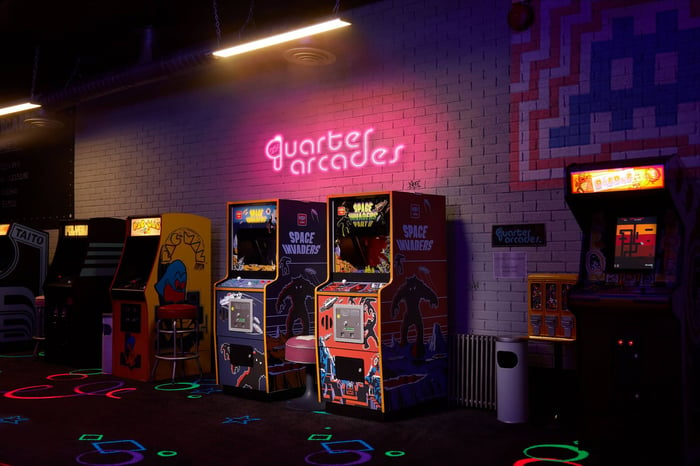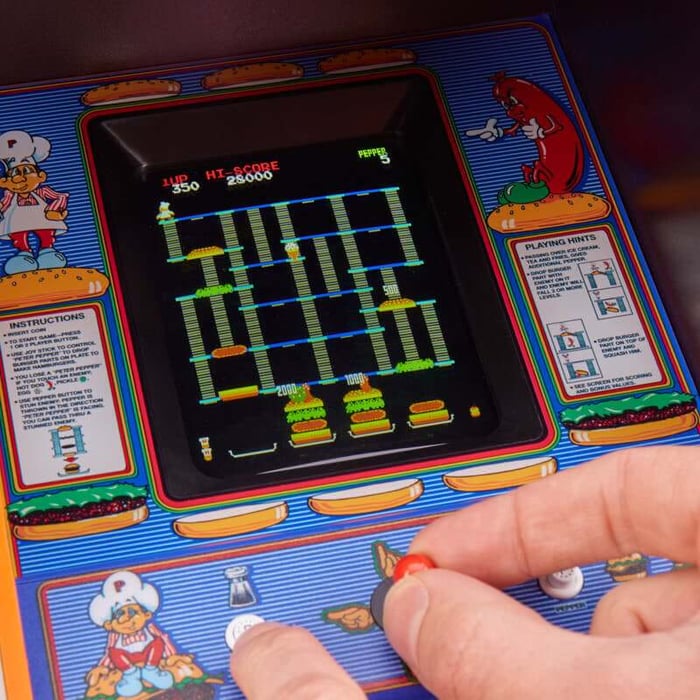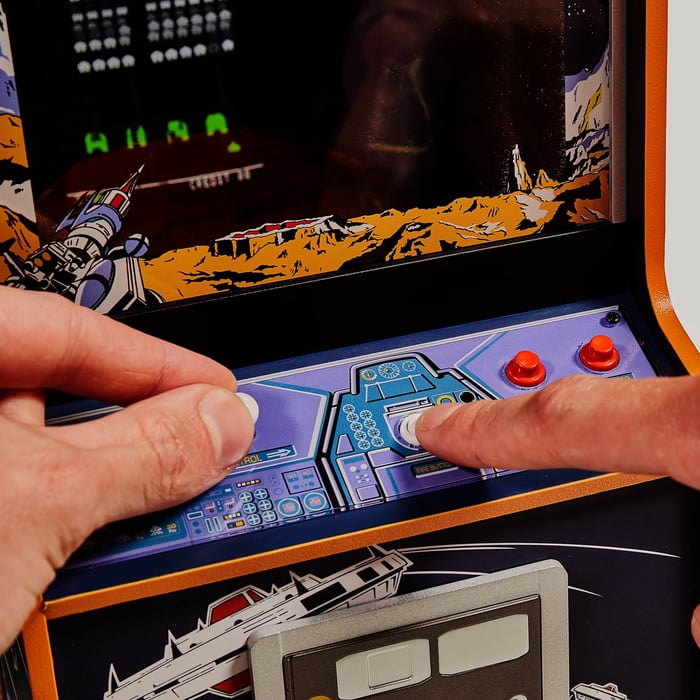The glowing screens of arcade cabinets didn't just entertain, they revolutionised an entire industry. From the vector-rendered wireframes of Space Invaders to the vibrant sprites of Street Fighter II, arcade games consistently pushed the boundaries of what was possible in interactive entertainment.
These coin-operated pioneers established visual standards that would influence home gaming for decades, creating a technological arms race that continues to shape gaming today.
The Hardware Advantage: Why Arcade Graphics Dominated
Arcade machines possessed a fundamental advantage over home systems: they weren't constrained by consumer pricing. While home console manufacturers had to balance performance with affordability, arcade operators could invest in cutting-edge hardware, knowing that quarters would eventually recoup the costs.
Specialised Components - Arcade cabinets featured dedicated graphics chips, higher-quality monitors, and specialised processors that home systems couldn't match. Games like Neo Geo titles used hardware that would have made a home console prohibitively expensive, featuring 24-bit colour depth and massive sprite capabilities that dwarfed contemporary home systems.
No Compromise Design - Arcade hardware was designed for maximum performance, unlike home consoles that needed to work reliably in various environments with minimal maintenance. This allowed developers to push visual boundaries without worrying about cost constraints or consumer-friendly packaging.
Vector Graphics: The Sharp Edge of Innovation
Arcade games pioneered vector graphics technology in the late 1970s and early 1980s, creating visuals with razor-sharp lines and smooth animations that raster-based systems couldn't match. Games like Asteroids (1979), Battlezone (1980), and Tempest (1981) showcased this technology's potential.
Technical Superiority Vector graphics used electron beam deflection to draw lines directly onto the screen, resulting in crisp, high-contrast visuals with perfect geometric precision. This technology was particularly effective for space-themed games and abstract geometric designs.
The Aesthetic Legacy While vector graphics eventually gave way to raster displays due to cost and colour limitations, their aesthetic influence persisted. The clean, wireframe look became synonymous with futuristic design and continues to inspire modern games and visual effects.
The Sprite Revolution: Bringing Characters to Life
The introduction of sprite graphics in arcade games revolutionised character animation and environmental design. Sprites—small, movable graphical objects—allowed for detailed characters and smooth animations that were impossible with earlier tile-based systems.
Advanced Animation Systems - Arcade games like Street Fighter and Fatal Fury featured large, detailed sprites with fluid animation frames that showcased fighting moves with unprecedented clarity. These games established visual standards for character animation that influenced fighting games for decades.
Colour and Detail Innovation - By the late 1980s, arcade systems could display thousands of colours simultaneously, enabling rich, detailed sprite graphics. Games like Metal Slug pushed sprite art to new heights, featuring hand-drawn animation quality that rivalled traditional animation.
Setting Visual Design Standards
Colour Palette Innovation - Arcade games established the importance of vibrant, distinctive colour palettes. Games like Pac-Man proved that strong visual design could create iconic, memorable imagery even with limited colours.
By 1980, colour graphics became standard for arcade games, setting expectations that home systems would eventually need to match.
Screen Resolution Leadership - Arcade monitors typically offered higher resolutions than home televisions, allowing for sharper, more detailed graphics. This resolution advantage gave arcade games a visual clarity that home ports often struggled to replicate.
The Pressure on Home Consoles
The Graphics Gap - Throughout the 1980s and early 1990s, there was a consistent "graphics gap" between arcade and home systems. Popular arcade games like Street Fighter II looked significantly better than their home console ports, creating consumer demand for more powerful home hardware.
Innovation Through Limitation - This gap forced home console developers to innovate creatively. Nintendo's development of technologies like Mode 7 graphics and specialised chips (like the Super FX chip) was a direct response to the need to bring arcade-quality visuals home.
Influence on Game Design Philosophy
Visual-First Development - Arcade games established the principle that striking visuals were crucial for attracting players. The "attract mode"—the demo screens that played when no one was actively playing - became an art form in itself, designed to draw players with impressive graphics and animations.
Standardising User Interface - Arcade games developed many of the visual interface conventions still used today: health bars, score displays, and character selection screens. These elements became so standardised that they were adopted wholesale by home games.
The Technical Innovation Pipeline
Research and Development - Arcade manufacturers like Sega, Capcom, and SNK often served as R&D labs for graphics technology. Innovations developed for arcade games eventually found their way into home consoles, often years later, when the technology became affordable.
3D Graphics Pioneers - Games like Virtua Fighter and Ridge Racer introduced polygonal 3D graphics to the mainstream gaming audience through arcades. These games established visual standards for 3D gaming that home consoles would later adopt with systems like the PlayStation and Sega Saturn.
The Transition Era: When Home Caught Up
The PlayStation Revolution - The mid-1990s marked a turning point when home consoles began matching arcade graphics quality. Sony's PlayStation demonstrated that home systems could deliver arcade-quality 3D graphics, marking the end of the arcade's graphics dominance.
The Last Stand - Games like The King of Fighters '98 and Tekken 3 represented the arcade industry's final push for graphics superiority before home systems definitively caught up.
Modern Legacy and Continued Influence
Aesthetic Influence - The visual design principles established by arcade games continue to influence modern gaming. The emphasis on bold colours, clear visual communication, and immediate visual impact remains central to game design.
Technical Standards - Many graphics technologies pioneered in arcades—from sprite scaling to polygon rendering became industry standards that shaped how all games are developed and displayed.
Cultural Impact - The graphics standards established by arcade games created lasting expectations about visual quality and innovation that continue to drive the gaming industry forward. The competitive pressure to create visually impressive games, first established in arcades, remains a primary force in gaming development.
Conclusion: The Lasting Visual Revolution
Arcade games didn't just set graphics standards; they established the very concept that visual innovation should drive gaming forward. From vector graphics to sprite animation, from colour palettes to 3D rendering, arcade games consistently demonstrated what was possible when graphics technology was pushed to its limits.
The influence of arcade graphics standards extends far beyond gaming. The emphasis on immediate visual impact, clear interface design, and technical innovation established in arcades can be seen in everything from modern mobile apps to virtual reality experiences.
Every time a game developer pushes for better graphics or more impressive visual effects, they follow a path first carved by those pioneering arcade games that proved graphics weren't just decoration—they were the future of interactive entertainment.
The glowing screens of classic arcade cabinets may have dimmed, but the standards they set continue to illuminate the path forward for gaming graphics innovation.
This article explores the profound impact arcade games had on establishing graphics standards that continue to influence gaming today. For more insights into retro gaming culture and technology history, visit JustGeek.com.



















